Turning in Circles The Turning Characteristics

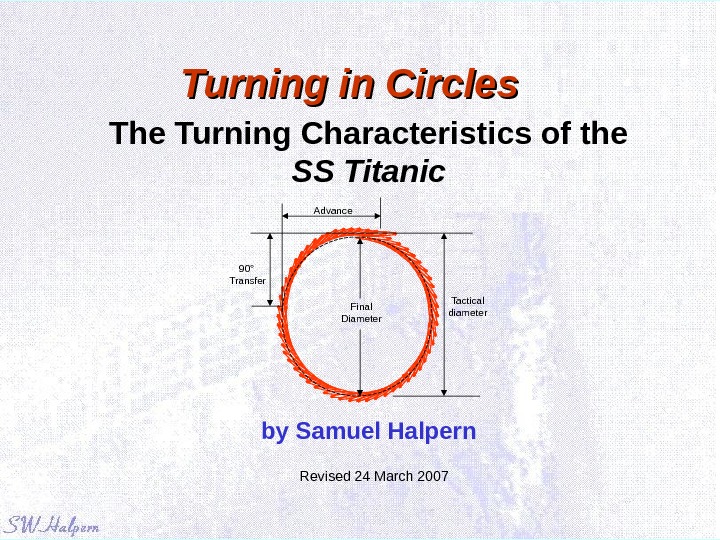
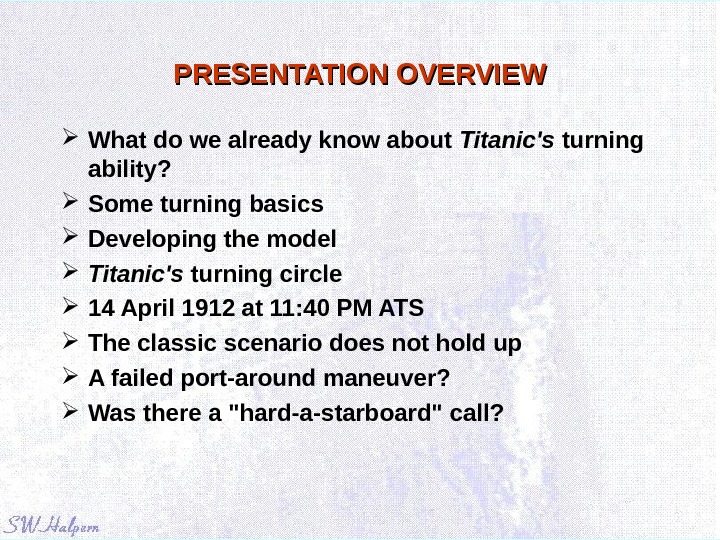


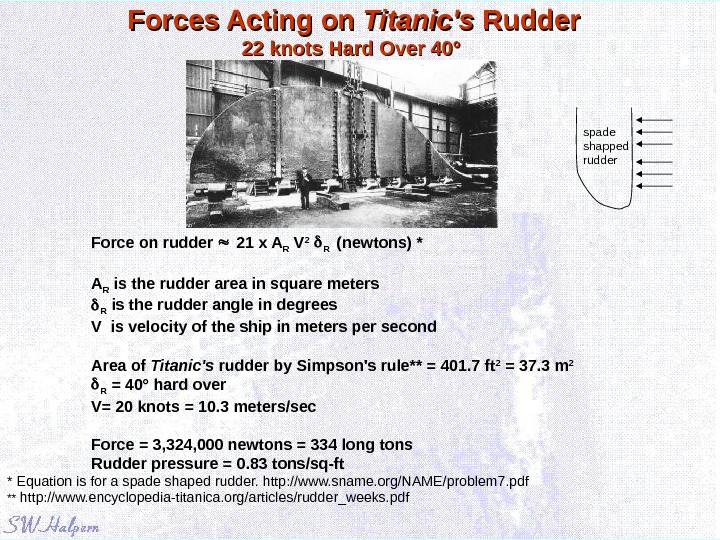

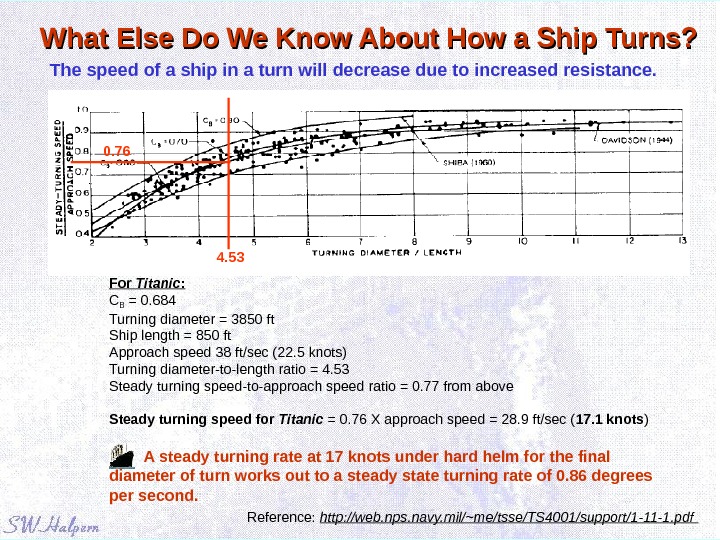
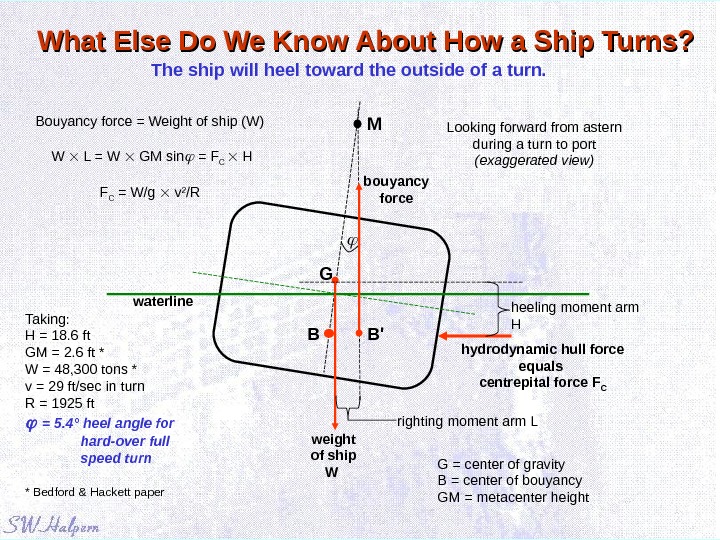
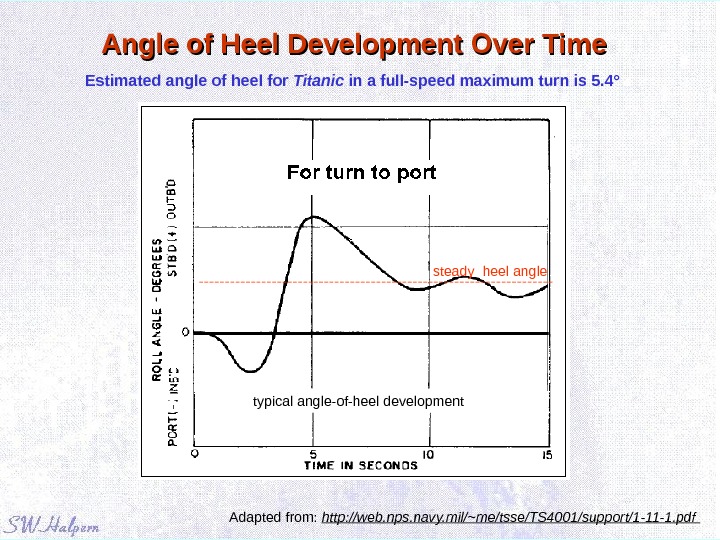
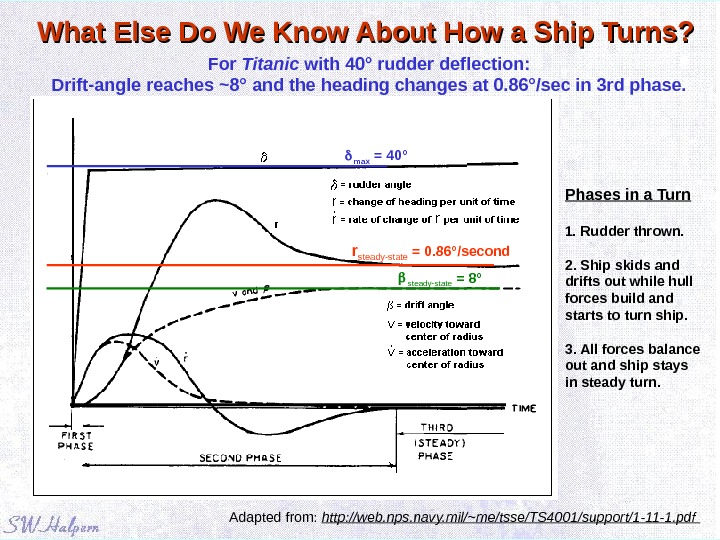

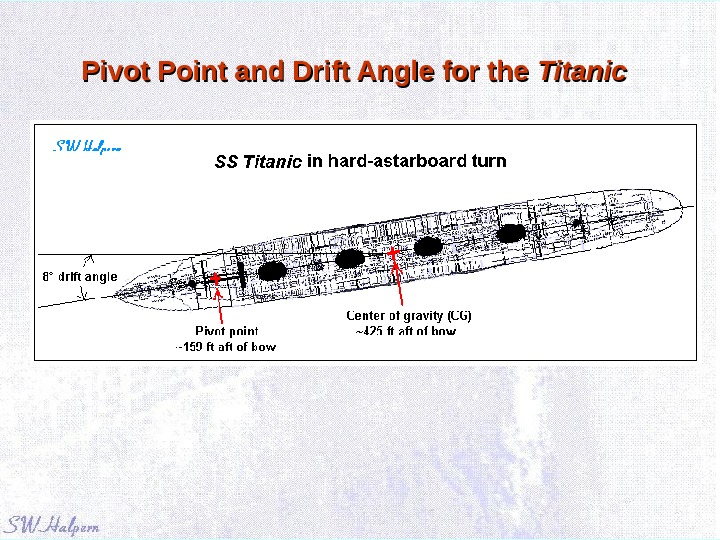
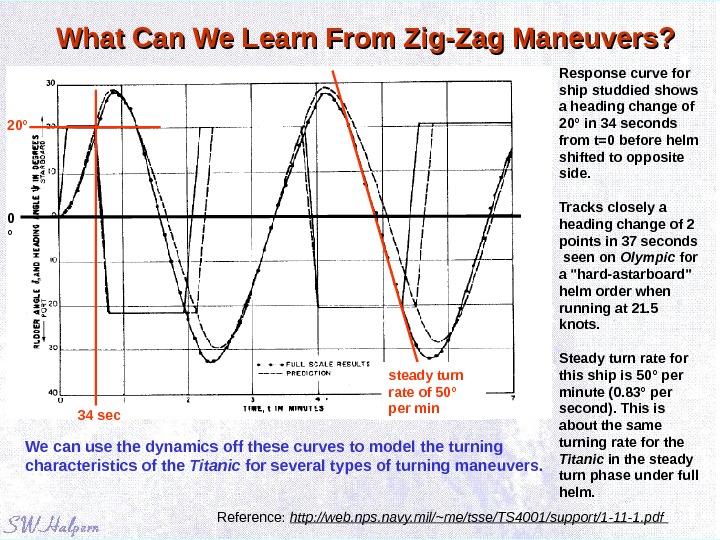

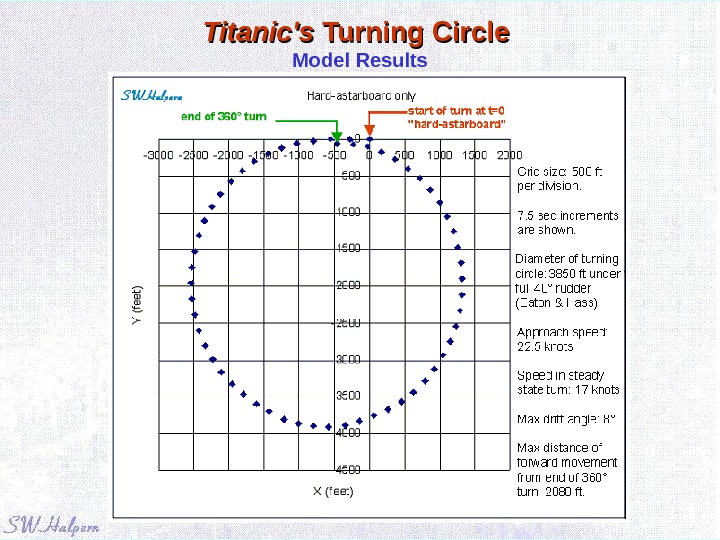
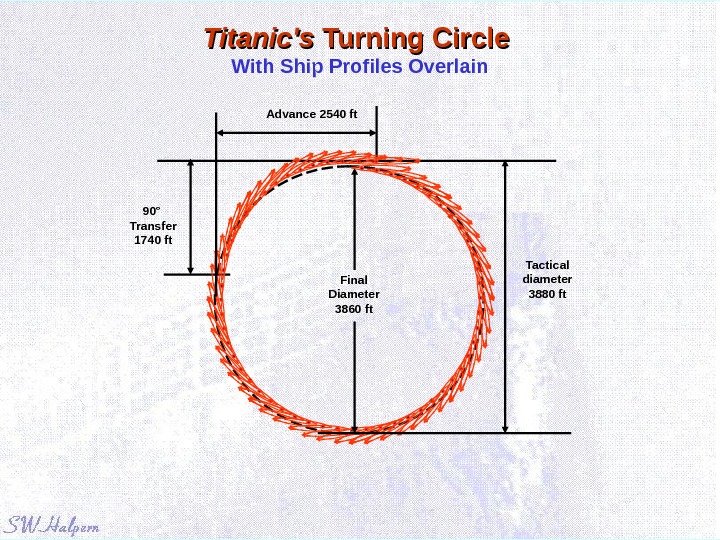
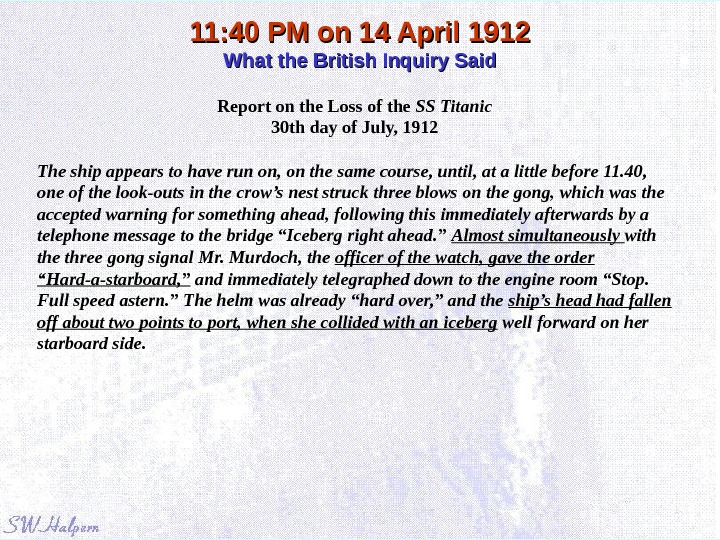
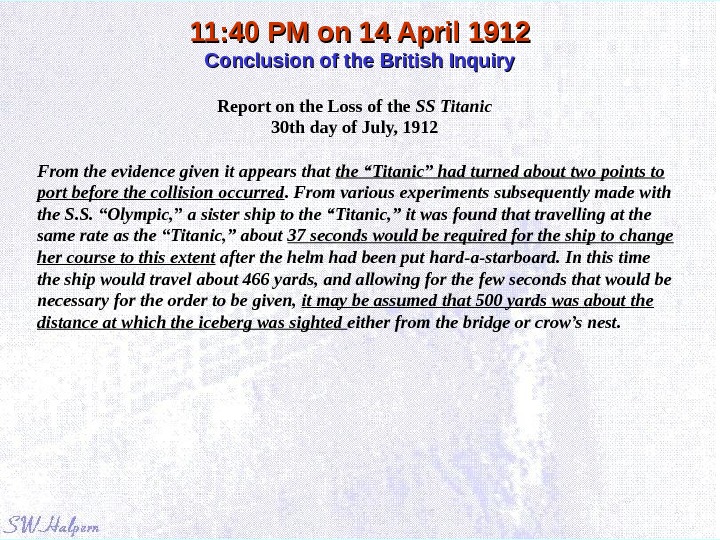


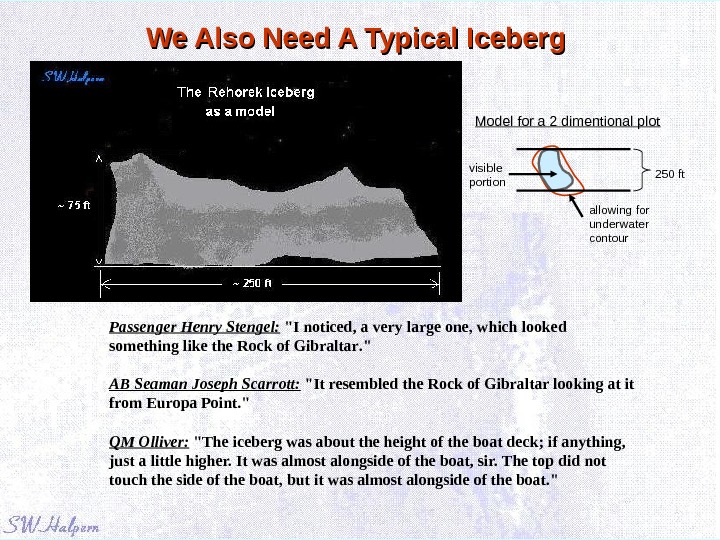


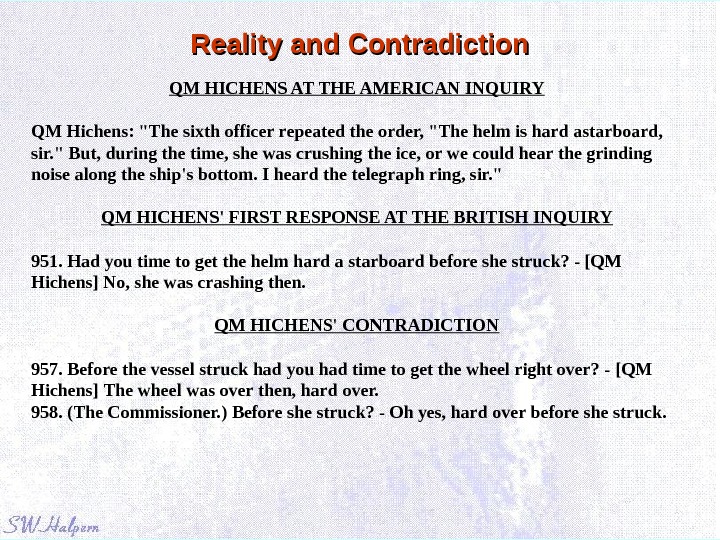

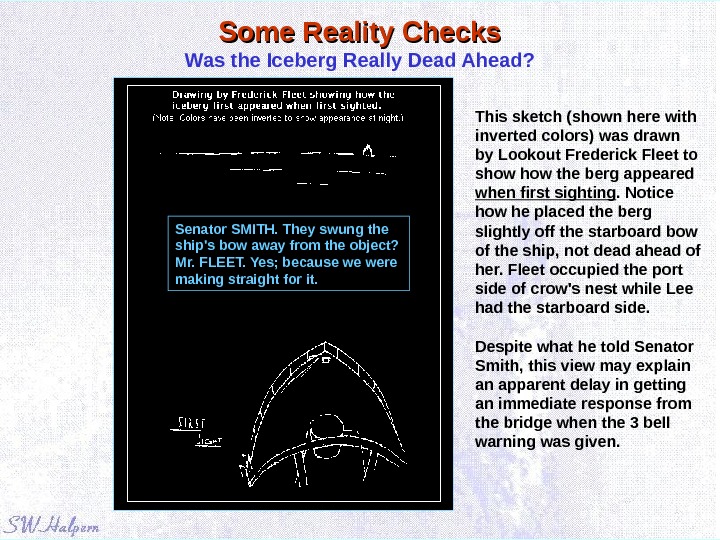
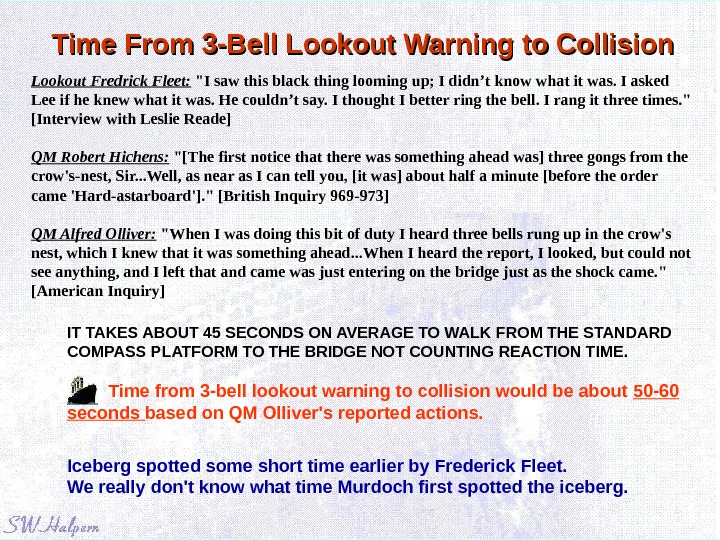
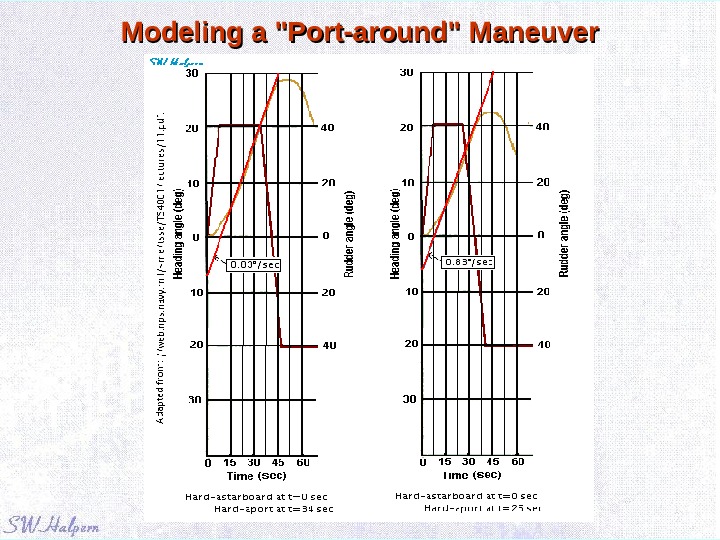
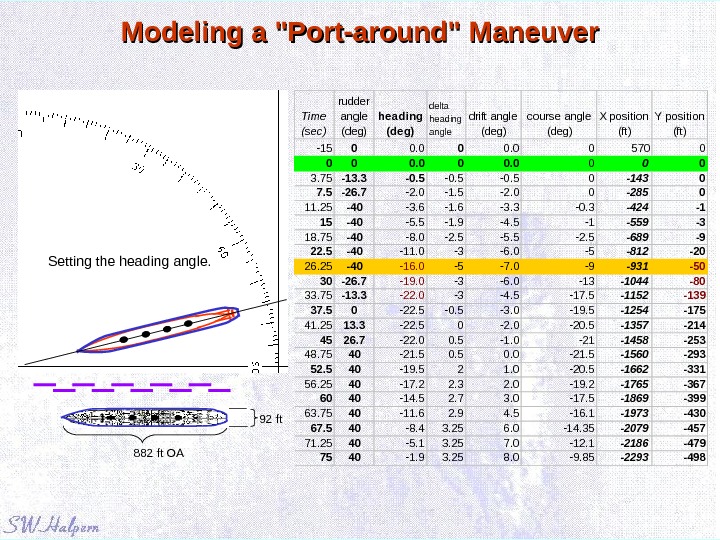
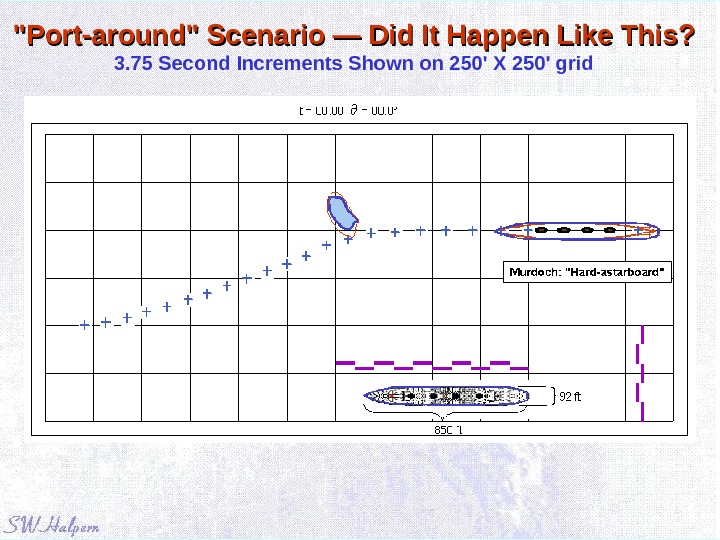
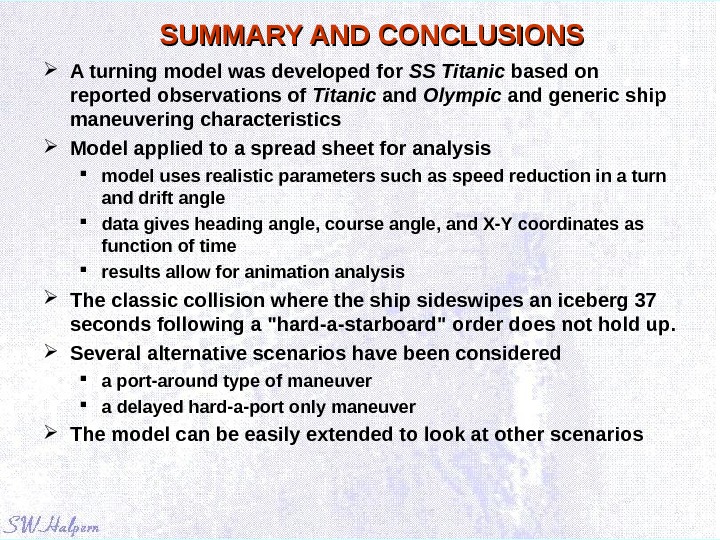
- Размер: 4.2 Mегабайта
- Количество слайдов: 31
Описание презентации Turning in Circles The Turning Characteristics по слайдам
 Turning in Circles The Turning Characteristics of the SS Titanic by Samuel Halpern Advance Tactical diameter 90° Transfer Final Diameter Revised 24 March
Turning in Circles The Turning Characteristics of the SS Titanic by Samuel Halpern Advance Tactical diameter 90° Transfer Final Diameter Revised 24 March
 PRESENTATION OVERVIEW What do we already know about Titanic’s turning ability? Some turning basics Developing the model Titanic’s turning circle 14 April 1912 at 11: 40 PM ATS The classic scenario does not hold up A failed port-around maneuver? Was there a «hard-a-starboard» call?
PRESENTATION OVERVIEW What do we already know about Titanic’s turning ability? Some turning basics Developing the model Titanic’s turning circle 14 April 1912 at 11: 40 PM ATS The classic scenario does not hold up A failed port-around maneuver? Was there a «hard-a-starboard» call?
 What Do We Already Know? • Titanic turned a full circle of 3850 ft measured diameter at 20. 5 knots during her sea trials off Belfast Lough. 1 • Forward travel for the hard turn was reported at 2100 feet. 1, 3 • A hard-a-starboard (left full rudder) order at 21. 5 knots results in a heading change of two points (22. 5 degrees) after 37 seconds. 2 • A hard-a-starboard (left full rudder) turn at 22 knots would result in a forward movement of about 440 yards (1320 ft) for a heading change of 2 points. 3, 4 • Small changes of speed do not significantly change the diameter of the turning circle, just the time it takes to turn a certain amount. 5 References: 1. Eaton & Haas, Titanic — Triumph and Tragedy , Ch. 4, 2 nd Ed. 2. Edward Wilding, British Inquiry (BI 25292). 3. Edward Wilding at Ryan Vs. Oceanic Steam Navigation Co. 4. Edward Wilding at the NY Limitation of Liability Hearings. 5. Mr. Roche (Marine Engineer’s Association) British Inquiry p. 770.
What Do We Already Know? • Titanic turned a full circle of 3850 ft measured diameter at 20. 5 knots during her sea trials off Belfast Lough. 1 • Forward travel for the hard turn was reported at 2100 feet. 1, 3 • A hard-a-starboard (left full rudder) order at 21. 5 knots results in a heading change of two points (22. 5 degrees) after 37 seconds. 2 • A hard-a-starboard (left full rudder) turn at 22 knots would result in a forward movement of about 440 yards (1320 ft) for a heading change of 2 points. 3, 4 • Small changes of speed do not significantly change the diameter of the turning circle, just the time it takes to turn a certain amount. 5 References: 1. Eaton & Haas, Titanic — Triumph and Tragedy , Ch. 4, 2 nd Ed. 2. Edward Wilding, British Inquiry (BI 25292). 3. Edward Wilding at Ryan Vs. Oceanic Steam Navigation Co. 4. Edward Wilding at the NY Limitation of Liability Hearings. 5. Mr. Roche (Marine Engineer’s Association) British Inquiry p. 770.
 Some Turning Basics Turning Circle — A ship’s turning circle is the path followed by the ship’s pivot point when making a 360 degree turn. Advance — Advance is the amount of distance run on the original course until the ship steadies on the new course. Advance is measured from the point where the rudder is first put over. Transfer — Transfer is the amount of distance gained towards the new course (shown here for 90° heading change). Tactical Diameter — Tactical diameter is the distance gained to the left or right of the original course after a turn of 180° is completed. Final Diameter — Final diameter is the distance perpendicular to the original course measured from the 180° point through 360° (shown here for steady turning radius, R). Pivot Point — A ship’s pivot point is a point on the centerline about which the ship turns when the rudder is put over. Drift Angle — Drift angle is an angle at any point on the turning circle between the intersection of the tangent at that point and the ship’s keel line. Reference: http: //web. nps. navy. mil/~me/tsse/TS 4001/support/1 -11 -1. pdf
Some Turning Basics Turning Circle — A ship’s turning circle is the path followed by the ship’s pivot point when making a 360 degree turn. Advance — Advance is the amount of distance run on the original course until the ship steadies on the new course. Advance is measured from the point where the rudder is first put over. Transfer — Transfer is the amount of distance gained towards the new course (shown here for 90° heading change). Tactical Diameter — Tactical diameter is the distance gained to the left or right of the original course after a turn of 180° is completed. Final Diameter — Final diameter is the distance perpendicular to the original course measured from the 180° point through 360° (shown here for steady turning radius, R). Pivot Point — A ship’s pivot point is a point on the centerline about which the ship turns when the rudder is put over. Drift Angle — Drift angle is an angle at any point on the turning circle between the intersection of the tangent at that point and the ship’s keel line. Reference: http: //web. nps. navy. mil/~me/tsse/TS 4001/support/1 -11 -1. pdf
 Forces Acting on Titanic’s Rudder 22 knots Hard Over 40° Force on rudder 21 x A R V 2 R (newtons) * A R is the rudder area in square meters R is the rudder angle in degrees V is velocity of the ship in meters per second Area of Titanic’s rudder by Simpson’s rule** = 401. 7 ft 2 = 37. 3 m 2 R = 40° hard over V= 20 knots = 10. 3 meters/sec Force = 3, 324, 000 newtons = 334 long tons Rudder pressure = 0. 83 tons/sq-ft * Equation is for a spade shaped rudder. http: //www. sname. org/NAME/problem 7. pdf ** http: //www. encyclopedia-titanica. org/articles/rudder_weeks. pdf spade shapped rudder
Forces Acting on Titanic’s Rudder 22 knots Hard Over 40° Force on rudder 21 x A R V 2 R (newtons) * A R is the rudder area in square meters R is the rudder angle in degrees V is velocity of the ship in meters per second Area of Titanic’s rudder by Simpson’s rule** = 401. 7 ft 2 = 37. 3 m 2 R = 40° hard over V= 20 knots = 10. 3 meters/sec Force = 3, 324, 000 newtons = 334 long tons Rudder pressure = 0. 83 tons/sq-ft * Equation is for a spade shaped rudder. http: //www. sname. org/NAME/problem 7. pdf ** http: //www. encyclopedia-titanica. org/articles/rudder_weeks. pdf spade shapped rudder
 What Else Do We Know About How a Ship Turns? The ship turns because of hydrodynamic forces on the hull, not the force acting on the rudder. direction of water flowdirection of ship movement rudder force hull force rudder force direction of water flowdirection of ship movementstraight approach start of turn — helm pushed over developing turn — build-up of hull forces Drag and propulsive forces not shown.
What Else Do We Know About How a Ship Turns? The ship turns because of hydrodynamic forces on the hull, not the force acting on the rudder. direction of water flowdirection of ship movement rudder force hull force rudder force direction of water flowdirection of ship movementstraight approach start of turn — helm pushed over developing turn — build-up of hull forces Drag and propulsive forces not shown.
 What Else Do We Know About How a Ship Turns? Reference: http: //web. nps. navy. mil/~me/tsse/TS 4001/support/1 -11 -1. pdf For Titanic : C B = 0. 684 Turning diameter = 3850 ft Ship length = 850 ft Approach speed 38 ft/sec (22. 5 knots) Turning diameter-to-length ratio = 4. 53 Steady turning speed-to-approach speed ratio = 0. 77 from above Steady turning speed for Titanic = 0. 76 X approach speed = 28. 9 ft/sec ( 17. 1 knots ) A steady turning rate at 17 knots under hard helm for the final diameter of turn works out to a steady state turning rate of 0. 86 degrees per second. The speed of a ship in a turn will decrease due to increased resistance. 4. 530.
What Else Do We Know About How a Ship Turns? Reference: http: //web. nps. navy. mil/~me/tsse/TS 4001/support/1 -11 -1. pdf For Titanic : C B = 0. 684 Turning diameter = 3850 ft Ship length = 850 ft Approach speed 38 ft/sec (22. 5 knots) Turning diameter-to-length ratio = 4. 53 Steady turning speed-to-approach speed ratio = 0. 77 from above Steady turning speed for Titanic = 0. 76 X approach speed = 28. 9 ft/sec ( 17. 1 knots ) A steady turning rate at 17 knots under hard helm for the final diameter of turn works out to a steady state turning rate of 0. 86 degrees per second. The speed of a ship in a turn will decrease due to increased resistance. 4. 530.
 What Else Do We Know About How a Ship Turns? The ship will heel toward the outside of a turn. G = center of gravity B = center of bouyancy GM = metacenter height. Bouyancy force = Weight of ship (W) W L = W GM sin = F C H F C = W/g v 2 /R Taking: H = 18. 6 ft GM = 2. 6 ft * W = 48, 300 tons * v = 29 ft/sec in turn R = 1925 ft = 5. 4° heel angle for hard-over full speed turn G B’ weight of ship W bouyancy force waterline hydrodynamic hull force equals centrepital force F C righting moment arm L heeling moment arm HLooking forward from astern during a turn to port (exaggerated view) M B * Bedford & Hackett paper
What Else Do We Know About How a Ship Turns? The ship will heel toward the outside of a turn. G = center of gravity B = center of bouyancy GM = metacenter height. Bouyancy force = Weight of ship (W) W L = W GM sin = F C H F C = W/g v 2 /R Taking: H = 18. 6 ft GM = 2. 6 ft * W = 48, 300 tons * v = 29 ft/sec in turn R = 1925 ft = 5. 4° heel angle for hard-over full speed turn G B’ weight of ship W bouyancy force waterline hydrodynamic hull force equals centrepital force F C righting moment arm L heeling moment arm HLooking forward from astern during a turn to port (exaggerated view) M B * Bedford & Hackett paper
 Angle of Heel Development Over Time Estimated angle of heel for Titanic in a full-speed maximum turn is 5. 4° Adapted from: http: //web. nps. navy. mil/~me/tsse/TS 4001/support/1 -11 -1. pdf typical angle-of-heel development steady heel angle
Angle of Heel Development Over Time Estimated angle of heel for Titanic in a full-speed maximum turn is 5. 4° Adapted from: http: //web. nps. navy. mil/~me/tsse/TS 4001/support/1 -11 -1. pdf typical angle-of-heel development steady heel angle
 What Else Do We Know About How a Ship Turns? For Titanic with 40° rudder deflection: Drift-angle reaches ~8° and the h eading changes at 0. 86°/sec in 3 rd phase. max = 40° r steady-state = 0. 86°/second steady-state = 8° Adapted from: http: //web. nps. navy. mil/~me/tsse/TS 4001/support/1 -11 -1. pdf Phases in a Turn 1. Rudder thrown. 2. Ship skids and drifts out while hull forces build and starts to turn ship. 3. All forces balance out and ship stays in steady turn.
What Else Do We Know About How a Ship Turns? For Titanic with 40° rudder deflection: Drift-angle reaches ~8° and the h eading changes at 0. 86°/sec in 3 rd phase. max = 40° r steady-state = 0. 86°/second steady-state = 8° Adapted from: http: //web. nps. navy. mil/~me/tsse/TS 4001/support/1 -11 -1. pdf Phases in a Turn 1. Rudder thrown. 2. Ship skids and drifts out while hull forces build and starts to turn ship. 3. All forces balance out and ship stays in steady turn.
 Determining Pivot Points and Drift Angles The drift angle in degrees can be taken as β = 18 L/R (in degrees). For Titanic, β = 7. 95 8°. The location of the pivot point is X = R sin β ahead of the center of gravity of the ship. For Titanic, X = 266 ft ahead of bulkhead H, or about 159 feet back from the bow (app. 1/6 th shiplength) under the forward well deck. Reference: http: //web. nps. navy. mil/~m e/tsse/TS 4001/support/1 -1 1 -1. pdf Path of CG of ship in the turn Drift angle Heading angle Velocity vector Center of turn. Direction of ship movement = Pivot point Center of Gravity (CG)ship’s extended centerline Steady turning radius R 1925 ft ship length L 850 ft BP X
Determining Pivot Points and Drift Angles The drift angle in degrees can be taken as β = 18 L/R (in degrees). For Titanic, β = 7. 95 8°. The location of the pivot point is X = R sin β ahead of the center of gravity of the ship. For Titanic, X = 266 ft ahead of bulkhead H, or about 159 feet back from the bow (app. 1/6 th shiplength) under the forward well deck. Reference: http: //web. nps. navy. mil/~m e/tsse/TS 4001/support/1 -1 1 -1. pdf Path of CG of ship in the turn Drift angle Heading angle Velocity vector Center of turn. Direction of ship movement = Pivot point Center of Gravity (CG)ship’s extended centerline Steady turning radius R 1925 ft ship length L 850 ft BP X
 Pivot Point and Drift Angle for the Titanic
Pivot Point and Drift Angle for the Titanic
 What Can We Learn From Zig-Zag Maneuvers? Reference: http: //web. nps. navy. mil/~me/tsse/TS 4001/support/1 -11 -1. pdf Response curve for ship studdied shows a heading change of 20° in 34 seconds from t=0 before helm shifted to opposite side. Tracks closely a heading change of 2 points in 37 seconds seen on Olympic for a «hard-astarboard» helm order when running at 21. 5 knots. Steady turn rate for this ship is 50° per minute (0. 83° per second). This is about the same turning rate for the Titanic in the steady turn phase under full helm. We can use the dynamics off these curves to model the turning characteristics of the Titanic for several types of turning maneuvers. 34 sec 20° steady turn rate of 50° per min 0 °
What Can We Learn From Zig-Zag Maneuvers? Reference: http: //web. nps. navy. mil/~me/tsse/TS 4001/support/1 -11 -1. pdf Response curve for ship studdied shows a heading change of 20° in 34 seconds from t=0 before helm shifted to opposite side. Tracks closely a heading change of 2 points in 37 seconds seen on Olympic for a «hard-astarboard» helm order when running at 21. 5 knots. Steady turn rate for this ship is 50° per minute (0. 83° per second). This is about the same turning rate for the Titanic in the steady turn phase under full helm. We can use the dynamics off these curves to model the turning characteristics of the Titanic for several types of turning maneuvers. 34 sec 20° steady turn rate of 50° per min 0 °
 Spread Sheet Analysisspeed (knots) speed (ft/sec) incremental distance in 7. 5 sec percent max 22. 538285100%initial 21. 33627095% 19. 53324887% 18. 43123382% 172921876%in full turn. . Time (sec) rudder angle (deg) he a ding (de g) delta heading angle drift angle (deg) course angle (deg) X position (ft) Y position (ft) -15 0 0 570 0 -7. 5 0 0 285 0 0 0 7. 5 -40 -2 -2 0 -285 0 15 -40 -5. 0 -3 -5 0 -555 0 22. 5 -40 -11. 0 -6 -6 -5 -802 -22 30 -40 -17. 5 -6. 47 -8 -9. 47 -1032 -60 37. 5 -40 -23. 9 -6. 47 -8 -15. 94 -1242 -120 45 -40 -30. 4 -6. 47 -8 -22. 41 -1443 -203 52. 5 -40 -36. 9 -6. 47 -8 -28. 88 -1634 -308 60 -43. 4 -6. 47 -8 -35. 35 -1812 -434 67. 5 -40 -49. 8 -6. 47 -8 -41. 82 -1974 -580 75 -40 -56. 3 -6. 47 -8 -48. 29 -2119 -742 82. 5 -40 -62. 8 -6. 47 -8 -54. 76 -2245 -920 90 -40 -69. 2 -6. 47 -8 -61. 23 -2350 -1112 97. 5 -40 -75. 7 -6. 47 -8 -67. 7 -2433 -1313 105 -40 -82. 2 -6. 47 -8 -74. 17 -2492 -1523 112. 5 -40 -88. 6 -6. 47 -8 -80. 64 -2528 -1738 120 -40 -95. 1 -6. 47 -8 -87. 11 -2539 -1956 127. 5 -40 -101. 6 -6. 47 -8 -93. 58 -2525 -2173 135 -40 -108. 1 -6. 47 -8 -100. 05 -2487 -2388 420 -40 -353. 9 -6. 47 -8 -345. 91 -242 -47 427. 5 -40 -360. 4 -6. 47 -8 -352. 38 -458 -18 435 -40 -366. 9 -6. 47 -8 -358. 85 -676 —
Spread Sheet Analysisspeed (knots) speed (ft/sec) incremental distance in 7. 5 sec percent max 22. 538285100%initial 21. 33627095% 19. 53324887% 18. 43123382% 172921876%in full turn. . Time (sec) rudder angle (deg) he a ding (de g) delta heading angle drift angle (deg) course angle (deg) X position (ft) Y position (ft) -15 0 0 570 0 -7. 5 0 0 285 0 0 0 7. 5 -40 -2 -2 0 -285 0 15 -40 -5. 0 -3 -5 0 -555 0 22. 5 -40 -11. 0 -6 -6 -5 -802 -22 30 -40 -17. 5 -6. 47 -8 -9. 47 -1032 -60 37. 5 -40 -23. 9 -6. 47 -8 -15. 94 -1242 -120 45 -40 -30. 4 -6. 47 -8 -22. 41 -1443 -203 52. 5 -40 -36. 9 -6. 47 -8 -28. 88 -1634 -308 60 -43. 4 -6. 47 -8 -35. 35 -1812 -434 67. 5 -40 -49. 8 -6. 47 -8 -41. 82 -1974 -580 75 -40 -56. 3 -6. 47 -8 -48. 29 -2119 -742 82. 5 -40 -62. 8 -6. 47 -8 -54. 76 -2245 -920 90 -40 -69. 2 -6. 47 -8 -61. 23 -2350 -1112 97. 5 -40 -75. 7 -6. 47 -8 -67. 7 -2433 -1313 105 -40 -82. 2 -6. 47 -8 -74. 17 -2492 -1523 112. 5 -40 -88. 6 -6. 47 -8 -80. 64 -2528 -1738 120 -40 -95. 1 -6. 47 -8 -87. 11 -2539 -1956 127. 5 -40 -101. 6 -6. 47 -8 -93. 58 -2525 -2173 135 -40 -108. 1 -6. 47 -8 -100. 05 -2487 -2388 420 -40 -353. 9 -6. 47 -8 -345. 91 -242 -47 427. 5 -40 -360. 4 -6. 47 -8 -352. 38 -458 -18 435 -40 -366. 9 -6. 47 -8 -358. 85 -676 —
 Titanic’s Turning Circle Model Results
Titanic’s Turning Circle Model Results
 Titanic’s Turning Circle With Ship Profiles Overlain Advance 2540 ft Tactical diameter 3880 ft 90° Transfer 1740 ft Final Diameter 3860 ft
Titanic’s Turning Circle With Ship Profiles Overlain Advance 2540 ft Tactical diameter 3880 ft 90° Transfer 1740 ft Final Diameter 3860 ft
 11: 40 PM on 14 April 1912 What the British Inquiry Said Report on the Loss of the SS Titanic 30 th day of July, 1912 The ship appears to have run on, on the same course, until, at a little before 11. 40, one of the look-outs in the crow’s nest struck three blows on the gong, which was the accepted warning for something ahead, following this immediately afterwards by a telephone message to the bridge “Iceberg right ahead. ” Almost simultaneously with the three gong signal Mr. Murdoch, the officer of the watch, gave the order “Hard-a-starboard, ” and immediately telegraphed down to the engine room “Stop. Full speed astern. ” The helm was already “hard over, ” and the ship’s head had fallen off about two points to port, when she collided with an iceberg well forward on her starboard side.
11: 40 PM on 14 April 1912 What the British Inquiry Said Report on the Loss of the SS Titanic 30 th day of July, 1912 The ship appears to have run on, on the same course, until, at a little before 11. 40, one of the look-outs in the crow’s nest struck three blows on the gong, which was the accepted warning for something ahead, following this immediately afterwards by a telephone message to the bridge “Iceberg right ahead. ” Almost simultaneously with the three gong signal Mr. Murdoch, the officer of the watch, gave the order “Hard-a-starboard, ” and immediately telegraphed down to the engine room “Stop. Full speed astern. ” The helm was already “hard over, ” and the ship’s head had fallen off about two points to port, when she collided with an iceberg well forward on her starboard side.
 11: 40 PM on 14 April 1912 Conclusion of the British Inquiry Report on the Loss of the SS Titanic 30 th day of July, 1912 From the evidence given it appears that the “Titanic” had turned about two points to port before the collision occurred. From various experiments subsequently made with the S. S. “Olympic, ” a sister ship to the “Titanic, ” it was found that travelling at the same rate as the “Titanic, ” about 37 seconds would be required for the ship to change her course to this extent after the helm had been put hard-a-starboard. In this time the ship would travel about 466 yards, and allowing for the few seconds that would be necessary for the order to be given, it may be assumed that 500 yards was about the distance at which the iceberg was sighted either from the bridge or crow’s nest.
11: 40 PM on 14 April 1912 Conclusion of the British Inquiry Report on the Loss of the SS Titanic 30 th day of July, 1912 From the evidence given it appears that the “Titanic” had turned about two points to port before the collision occurred. From various experiments subsequently made with the S. S. “Olympic, ” a sister ship to the “Titanic, ” it was found that travelling at the same rate as the “Titanic, ” about 37 seconds would be required for the ship to change her course to this extent after the helm had been put hard-a-starboard. In this time the ship would travel about 466 yards, and allowing for the few seconds that would be necessary for the order to be given, it may be assumed that 500 yards was about the distance at which the iceberg was sighted either from the bridge or crow’s nest.
 What About the Engines Stopping or Reversing? Trimmer Thomas Dillon: «They stopped. . . about a minute and a half [after the collision]. They [then] went slow astern. . . about a minute and a half [later for] about two minutes. » Greaser Thomas Ranger: » We turned round and looked into the engine room and saw the turbine engine was stopped. . . T here are two arms [that] come up as the turbine engine stops. . . [that was] about two minutes afterwards. . . [after the jar. ]» 1 st Class Passenger Henry Stengel: «A s I woke up I heard a slight crash. I paid no attention to it until I heard the engines stop. . . [They were stopped] I should say two or three minutes, and then they started again just slightly; just started to move again. I do not know why; whether they were backing off, or not. » 1 st Class Passenger George Rheims: «I did notice that the engines were stopped right away; they were not stopped right away; of that I am positive. [I felt a change with reference to the engines] a few minutes after the shock, possibly two or three minutes; might have been less. » 2 nd Class Passenger Lawrence Beesley: » There came what seemed to me nothing more than an extra heave of the engines and a more than usually obvious dancing motion of the mattress. . . and presently the same thing repeated with about the same intensity. . . I continued my reading. . . But in a few moments I felt the engines slow and stop. » The engines did not stop nor reverse until some short amount of time after the ship struck the iceberg.
What About the Engines Stopping or Reversing? Trimmer Thomas Dillon: «They stopped. . . about a minute and a half [after the collision]. They [then] went slow astern. . . about a minute and a half [later for] about two minutes. » Greaser Thomas Ranger: » We turned round and looked into the engine room and saw the turbine engine was stopped. . . T here are two arms [that] come up as the turbine engine stops. . . [that was] about two minutes afterwards. . . [after the jar. ]» 1 st Class Passenger Henry Stengel: «A s I woke up I heard a slight crash. I paid no attention to it until I heard the engines stop. . . [They were stopped] I should say two or three minutes, and then they started again just slightly; just started to move again. I do not know why; whether they were backing off, or not. » 1 st Class Passenger George Rheims: «I did notice that the engines were stopped right away; they were not stopped right away; of that I am positive. [I felt a change with reference to the engines] a few minutes after the shock, possibly two or three minutes; might have been less. » 2 nd Class Passenger Lawrence Beesley: » There came what seemed to me nothing more than an extra heave of the engines and a more than usually obvious dancing motion of the mattress. . . and presently the same thing repeated with about the same intensity. . . I continued my reading. . . But in a few moments I felt the engines slow and stop. » The engines did not stop nor reverse until some short amount of time after the ship struck the iceberg.
 Applying the Model The turning model can be used to analyze several scenarios including: • The classic «hard-a-starboard» maneuver. • An attempted «port-around» maneuver. • A delayed «hard-a-port» maneuver.
Applying the Model The turning model can be used to analyze several scenarios including: • The classic «hard-a-starboard» maneuver. • An attempted «port-around» maneuver. • A delayed «hard-a-port» maneuver.
 We Also Need A Typical Iceberg Passenger Henry Stengel: » I noticed, a very large one, which looked something like the Rock of Gibraltar. » AB Seaman Joseph Scarrott: «I t resembled the Rock of Gibraltar looking at it from Europa Point. » QM Olliver: » The iceberg was about the height of the boat deck; if anything, just a little higher. It was almost alongside of the boat, sir. The top did not touch the side of the boat, but it was almost alongside of the boat. » 250 ftvisible portion allowing for underwater contour. Model for a 2 dimentional plot
We Also Need A Typical Iceberg Passenger Henry Stengel: » I noticed, a very large one, which looked something like the Rock of Gibraltar. » AB Seaman Joseph Scarrott: «I t resembled the Rock of Gibraltar looking at it from Europa Point. » QM Olliver: » The iceberg was about the height of the boat deck; if anything, just a little higher. It was almost alongside of the boat, sir. The top did not touch the side of the boat, but it was almost alongside of the boat. » 250 ftvisible portion allowing for underwater contour. Model for a 2 dimentional plot
 The «Hard-a-Starboard» Scenario 7. 5 Second Increments Shown on a 500′ X 500′ Grid
The «Hard-a-Starboard» Scenario 7. 5 Second Increments Shown on a 500′ X 500′ Grid
 What Do the Turning Model Results Say? A turn of «hard-a-starboard» 37 seconds before collision with no other corrective action would have likely produce severe damage along the entire starboard side.
What Do the Turning Model Results Say? A turn of «hard-a-starboard» 37 seconds before collision with no other corrective action would have likely produce severe damage along the entire starboard side.
 Reality and Contradiction QM HICHENS AT THE AMERICAN INQUIRY QM Hichens: «The sixth officer repeated the order, «The helm is hard astarboard, sir. » But, during the time, she was crushing the ice, or we could hear the grinding noise along the ship’s bottom. I heard the telegraph ring, sir. » QM HICHENS’ FIRST RESPONSE AT THE BRITISH INQUIRY 951. Had you time to get the helm hard a starboard before she struck? — [QM Hichens] No, she was crashing then. QM HICHENS’ CONTRADICTION 957. Before the vessel struck had you had time to get the wheel right over? — [QM Hichens] The wheel was over then, hard over. 958. (The Commissioner. ) Before she struck? — Oh yes, hard over before she struck.
Reality and Contradiction QM HICHENS AT THE AMERICAN INQUIRY QM Hichens: «The sixth officer repeated the order, «The helm is hard astarboard, sir. » But, during the time, she was crushing the ice, or we could hear the grinding noise along the ship’s bottom. I heard the telegraph ring, sir. » QM HICHENS’ FIRST RESPONSE AT THE BRITISH INQUIRY 951. Had you time to get the helm hard a starboard before she struck? — [QM Hichens] No, she was crashing then. QM HICHENS’ CONTRADICTION 957. Before the vessel struck had you had time to get the wheel right over? — [QM Hichens] The wheel was over then, hard over. 958. (The Commissioner. ) Before she struck? — Oh yes, hard over before she struck.
 Some Reality Checks QM Alfred Olliver: » I know the orders I heard when I was on the bridge was after we had struck the iceberg. I heard hard aport, and there was the man at the wheel and the officer. The officer was seeing it was carried out right. » AB Seaman Joseph Scarrott: » Under port helm. Her stern was slewing off the iceberg. Her starboard quarter was going off the iceberg, and the starboard bow was going as if to make a circle round it. » Fireman Alfred Shiers: » I saw the berg that was going away. . . on the starboard quarter, off the stern. «
Some Reality Checks QM Alfred Olliver: » I know the orders I heard when I was on the bridge was after we had struck the iceberg. I heard hard aport, and there was the man at the wheel and the officer. The officer was seeing it was carried out right. » AB Seaman Joseph Scarrott: » Under port helm. Her stern was slewing off the iceberg. Her starboard quarter was going off the iceberg, and the starboard bow was going as if to make a circle round it. » Fireman Alfred Shiers: » I saw the berg that was going away. . . on the starboard quarter, off the stern. «
 Some Reality Checks Was the Iceberg Really Dead Ahead? This sketch (shown here with inverted colors) was drawn by Lookout Frederick Fleet to show the berg appeared when first sighting. Notice how he placed the berg slightly off the starboard bow of the ship, not dead ahead of her. Fleet occupied the port side of crow’s nest while Lee had the starboard side. Despite what he told Senator Smith, this view may explain an apparent delay in getting an immediate response from the bridge when the 3 bell warning was given. Senator SMITH. They swung the ship’s bow away from the object? Mr. FLEET. Yes; because we were making straight for it.
Some Reality Checks Was the Iceberg Really Dead Ahead? This sketch (shown here with inverted colors) was drawn by Lookout Frederick Fleet to show the berg appeared when first sighting. Notice how he placed the berg slightly off the starboard bow of the ship, not dead ahead of her. Fleet occupied the port side of crow’s nest while Lee had the starboard side. Despite what he told Senator Smith, this view may explain an apparent delay in getting an immediate response from the bridge when the 3 bell warning was given. Senator SMITH. They swung the ship’s bow away from the object? Mr. FLEET. Yes; because we were making straight for it.
 Time From 3 -Bell Lookout Warning to Collision Lookout Fredrick Fleet: «I saw this black thing looming up; I didn’t know what it was. I asked Lee if he knew what it was. He couldn’t say. I thought I better ring the bell. I rang it three times. » [Interview with Leslie Reade] QM Robert Hichens: «[ The first notice that there was something ahead was] three gongs from the crow’s-nest, Sir. . . Well, as near as I can tell you, [it was] about half a minute [before the order came ‘Hard-astarboard’]. » [British Inquiry 969 -973] QM Alfred Olliver: » When I was doing this bit of duty I heard three bells rung up in the crow’s nest, which I knew that it was something ahead. . . When I heard the report, I looked, but could not see anything, and I left that and came was just entering on the bridge just as the shock came. » [American Inquiry] IT TAKES ABOUT 45 SECONDS ON AVERAGE TO WALK FROM THE STANDARD COMPASS PLATFORM TO THE BRIDGE NOT COUNTING REACTION TIME. Time from 3 -bell lookout warning to collision would be about 50 -60 seconds based on QM Olliver’s reported actions. Iceberg spotted some short time earlier by Frederick Fleet. We really don’t know what time Murdoch first spotted the iceberg.
Time From 3 -Bell Lookout Warning to Collision Lookout Fredrick Fleet: «I saw this black thing looming up; I didn’t know what it was. I asked Lee if he knew what it was. He couldn’t say. I thought I better ring the bell. I rang it three times. » [Interview with Leslie Reade] QM Robert Hichens: «[ The first notice that there was something ahead was] three gongs from the crow’s-nest, Sir. . . Well, as near as I can tell you, [it was] about half a minute [before the order came ‘Hard-astarboard’]. » [British Inquiry 969 -973] QM Alfred Olliver: » When I was doing this bit of duty I heard three bells rung up in the crow’s nest, which I knew that it was something ahead. . . When I heard the report, I looked, but could not see anything, and I left that and came was just entering on the bridge just as the shock came. » [American Inquiry] IT TAKES ABOUT 45 SECONDS ON AVERAGE TO WALK FROM THE STANDARD COMPASS PLATFORM TO THE BRIDGE NOT COUNTING REACTION TIME. Time from 3 -bell lookout warning to collision would be about 50 -60 seconds based on QM Olliver’s reported actions. Iceberg spotted some short time earlier by Frederick Fleet. We really don’t know what time Murdoch first spotted the iceberg.
 Modeling a «Port-around» Maneuver
Modeling a «Port-around» Maneuver
 Modeling a «Port-around» Maneuver 882 ft OA 92 ft. Setting the heading angle. Time (sec) rudder angle (deg) he a ding (de g) delta heading angle drift angle (deg) course angle (deg) X position (ft) Y position (ft) -15 0 0 570 0 0 0 3. 75 -13. 3 -0. 5 0 -143 0 7. 5 -26. 7 -2. 0 -1. 5 -2. 0 0 -285 0 11. 25 -40 -3. 6 -1. 6 -3. 3 -0. 3 -424 -1 15 -40 -5. 5 -1. 9 -4. 5 -1 -559 -3 18. 75 -40 -8. 0 -2. 5 -5. 5 -2. 5 -689 -9 22. 5 -40 -11. 0 -3 -6. 0 -5 -812 -20 26. 25 -40 -16. 0 -5 -7. 0 -9 -931 -50 30 -26. 7 -19. 0 -3 -6. 0 -13 -1044 -80 33. 75 -13. 3 -22. 0 -3 -4. 5 -17. 5 -1152 -139 37. 5 0 -22. 5 -0. 5 -3. 0 -19. 5 -1254 -175 41. 25 13. 3 -22. 5 0 -20. 5 -1357 -214 45 26. 7 -22. 0 0. 5 -1. 0 -21 -1458 -253 48. 75 40 -21. 5 0. 0 -21. 5 -1560 -293 52. 5 40 -19. 5 2 1. 0 -20. 5 -1662 -331 56. 25 40 -17. 2 2. 3 2. 0 -19. 2 -1765 -367 60 40 -14. 5 2. 7 3. 0 -17. 5 -1869 -399 63. 75 40 -11. 6 2. 9 4. 5 -16. 1 -1973 -430 67. 5 40 -8. 4 3. 25 6. 0 -14. 35 -2079 -457 71. 25 40 -5. 1 3. 25 7. 0 -12. 1 -2186 -479 75 40 -1. 9 3. 25 8. 0 -9. 85 -2293 —
Modeling a «Port-around» Maneuver 882 ft OA 92 ft. Setting the heading angle. Time (sec) rudder angle (deg) he a ding (de g) delta heading angle drift angle (deg) course angle (deg) X position (ft) Y position (ft) -15 0 0 570 0 0 0 3. 75 -13. 3 -0. 5 0 -143 0 7. 5 -26. 7 -2. 0 -1. 5 -2. 0 0 -285 0 11. 25 -40 -3. 6 -1. 6 -3. 3 -0. 3 -424 -1 15 -40 -5. 5 -1. 9 -4. 5 -1 -559 -3 18. 75 -40 -8. 0 -2. 5 -5. 5 -2. 5 -689 -9 22. 5 -40 -11. 0 -3 -6. 0 -5 -812 -20 26. 25 -40 -16. 0 -5 -7. 0 -9 -931 -50 30 -26. 7 -19. 0 -3 -6. 0 -13 -1044 -80 33. 75 -13. 3 -22. 0 -3 -4. 5 -17. 5 -1152 -139 37. 5 0 -22. 5 -0. 5 -3. 0 -19. 5 -1254 -175 41. 25 13. 3 -22. 5 0 -20. 5 -1357 -214 45 26. 7 -22. 0 0. 5 -1. 0 -21 -1458 -253 48. 75 40 -21. 5 0. 0 -21. 5 -1560 -293 52. 5 40 -19. 5 2 1. 0 -20. 5 -1662 -331 56. 25 40 -17. 2 2. 3 2. 0 -19. 2 -1765 -367 60 40 -14. 5 2. 7 3. 0 -17. 5 -1869 -399 63. 75 40 -11. 6 2. 9 4. 5 -16. 1 -1973 -430 67. 5 40 -8. 4 3. 25 6. 0 -14. 35 -2079 -457 71. 25 40 -5. 1 3. 25 7. 0 -12. 1 -2186 -479 75 40 -1. 9 3. 25 8. 0 -9. 85 -2293 —
 «Port-around» Scenario — Did It Happen Like This? 3. 75 Second Increments Shown on 250′ X 250′ grid
«Port-around» Scenario — Did It Happen Like This? 3. 75 Second Increments Shown on 250′ X 250′ grid
 SUMMARY AND CONCLUSIONS A turning model was developed for SS Titanic based on reported observations of Titanic and Olympic and generic ship maneuvering characteristics Model applied to a spread sheet for analysis model uses realistic parameters such as speed reduction in a turn and drift angle data gives heading angle, course angle, and X-Y coordinates as function of time results allow for animation analysis The classic collision where the ship sideswipes an iceberg 37 seconds following a «hard-a-starboard» order does not hold up. Several alternative scenarios have been considered a port-around type of maneuver a delayed hard-a-port only maneuver The model can be easily extended to look at other scenarios
SUMMARY AND CONCLUSIONS A turning model was developed for SS Titanic based on reported observations of Titanic and Olympic and generic ship maneuvering characteristics Model applied to a spread sheet for analysis model uses realistic parameters such as speed reduction in a turn and drift angle data gives heading angle, course angle, and X-Y coordinates as function of time results allow for animation analysis The classic collision where the ship sideswipes an iceberg 37 seconds following a «hard-a-starboard» order does not hold up. Several alternative scenarios have been considered a port-around type of maneuver a delayed hard-a-port only maneuver The model can be easily extended to look at other scenarios

